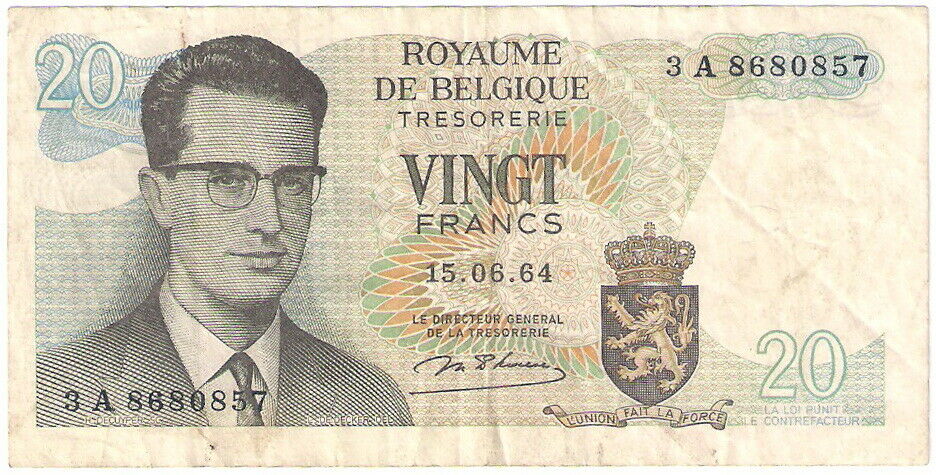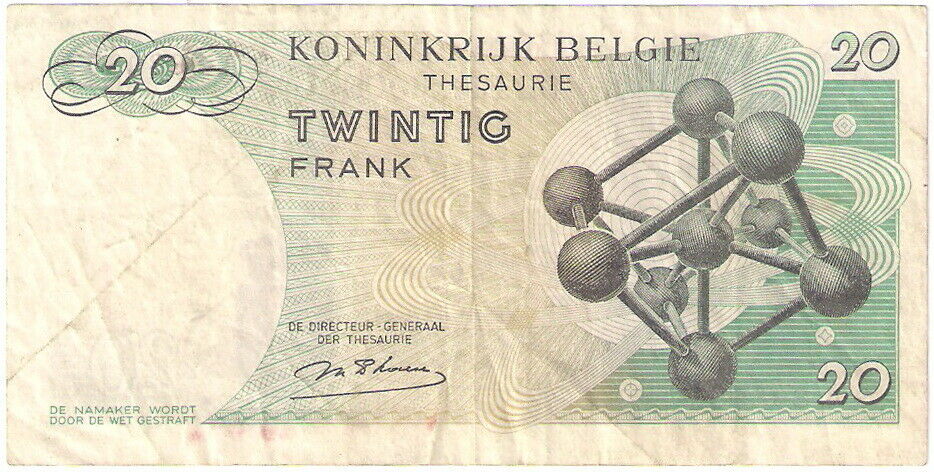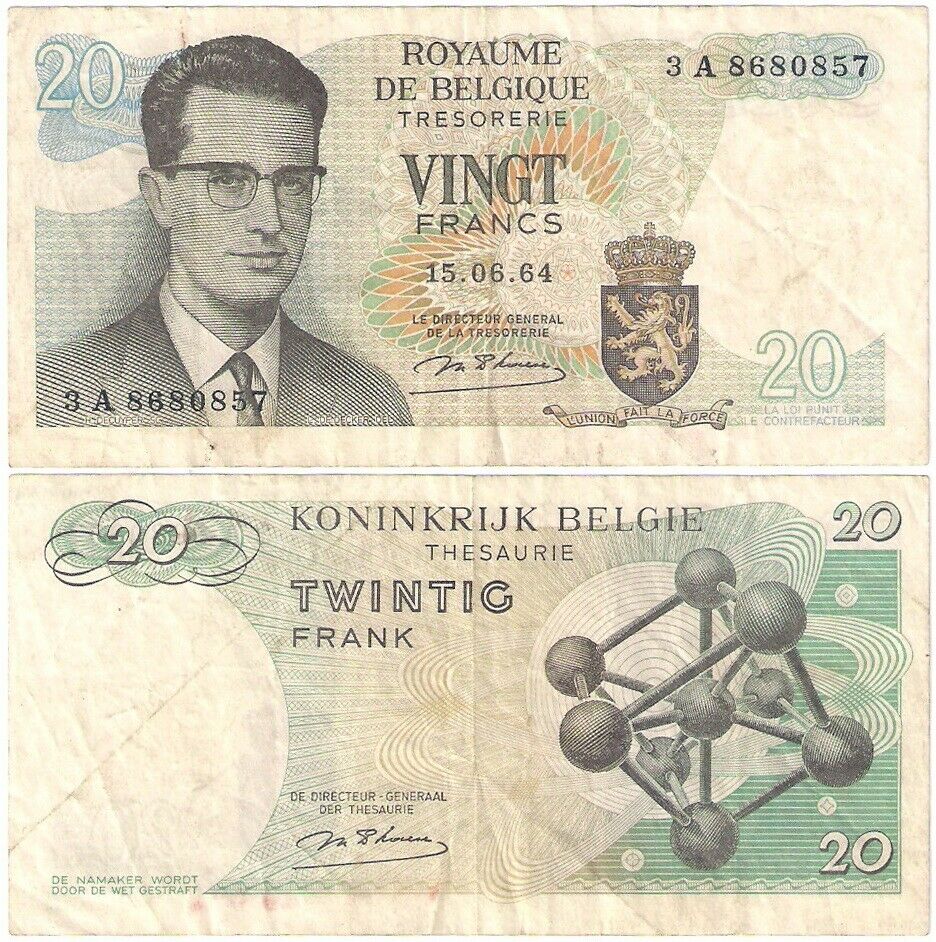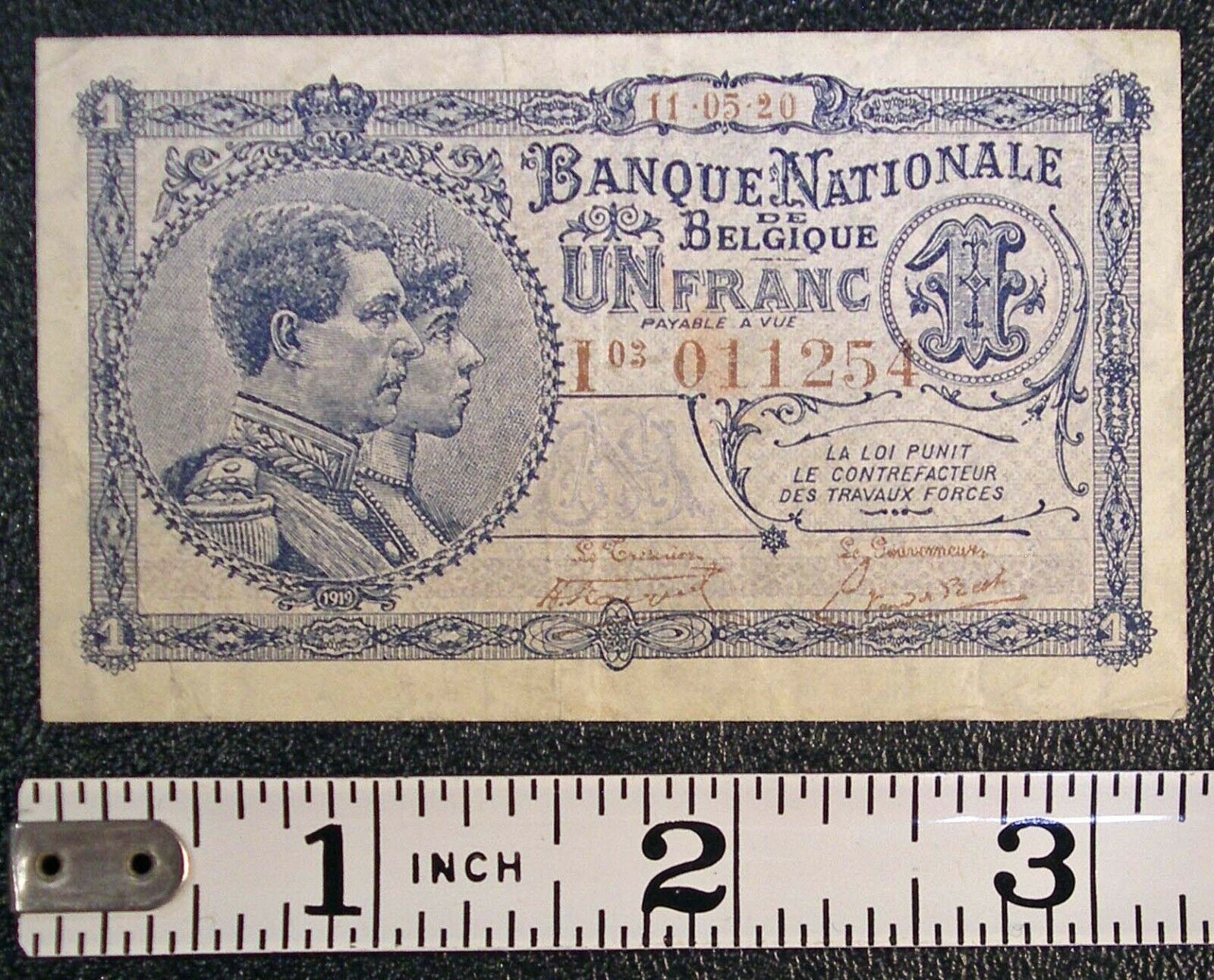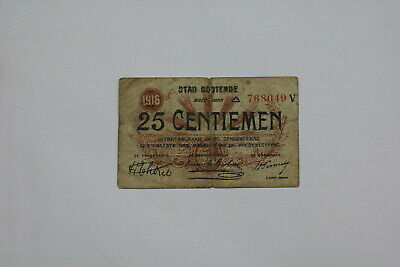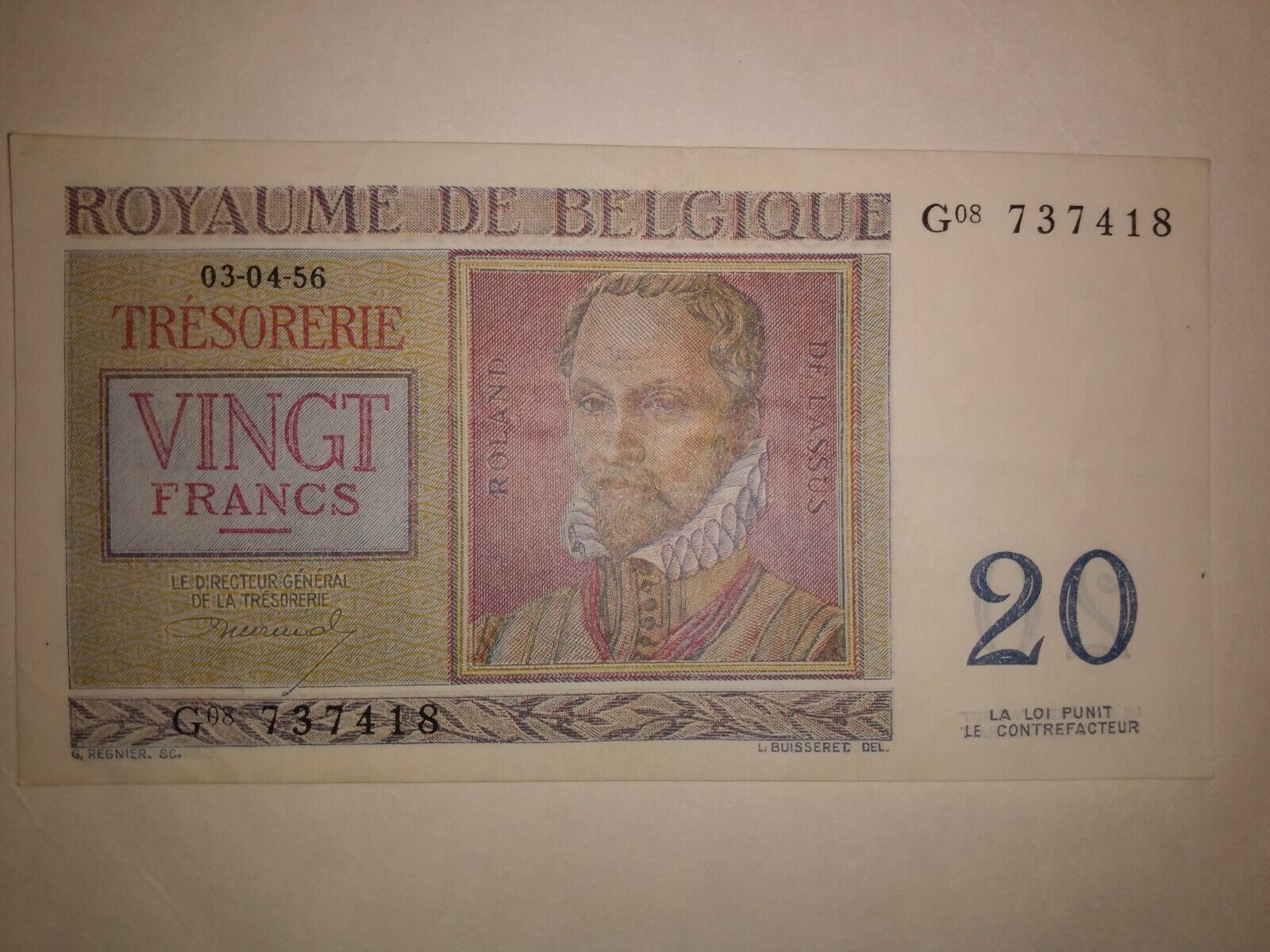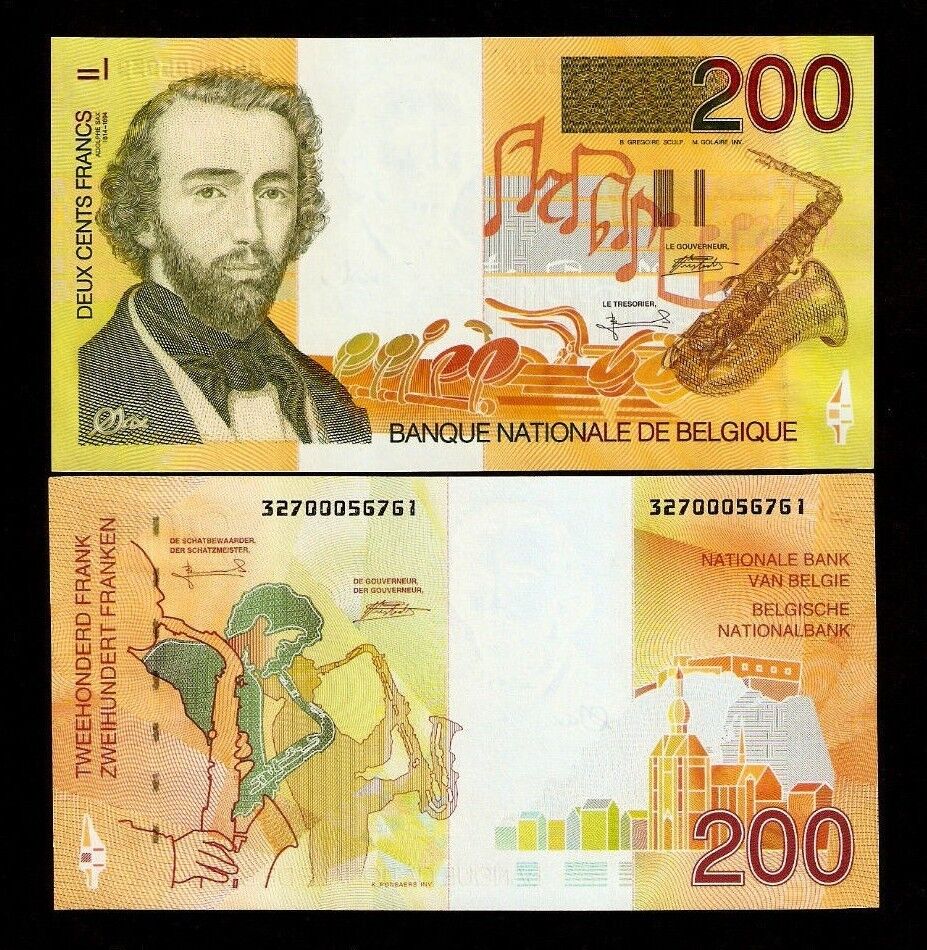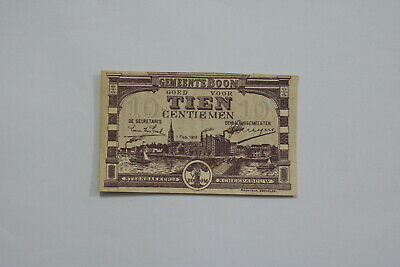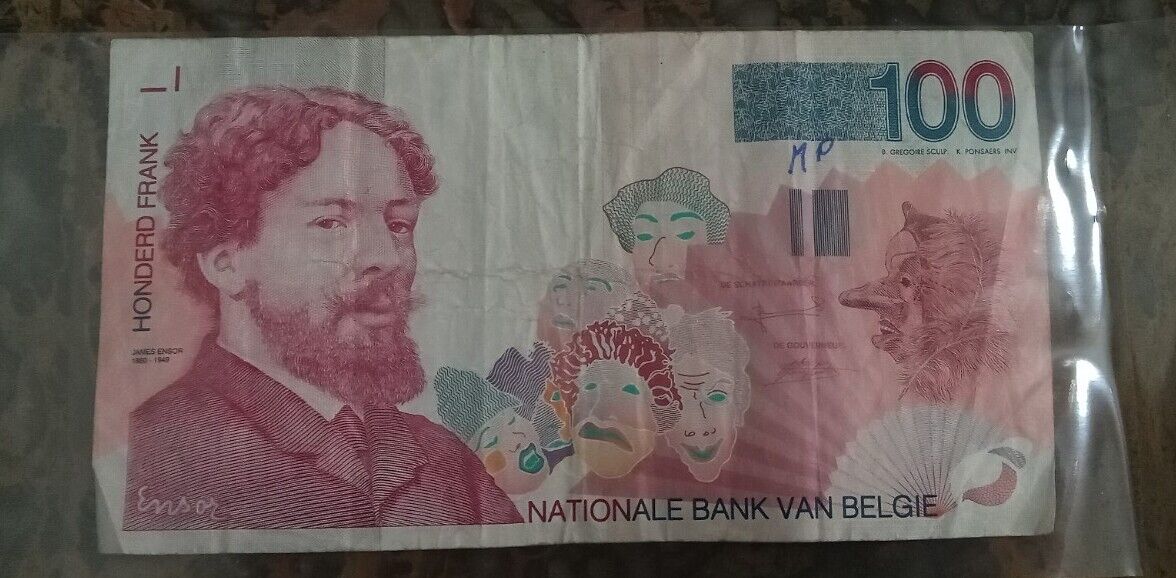-40%
Belgium banknote - 20 vingt franc - year 1964 - King Baudouin I - free shipping
$ 3.69
- Description
- Size Guide
Description
The Belgian franc (French: Franc belge, Dutch: Belgische frank, German: Belgischer Franken) was the currency of the Kingdom of Belgium from 1832 until 2002 when the Euro was introduced. It was subdivided into 100 subunits, known as centimes (French), centiem (Dutch) or Centime (German).The conquest of most of western Europe by revolutionary and Napoleonic France led to the French franc's wide circulation. In the Austrian Netherlands (the current Belgium), the franc replaced the kronenthaler. This was in turn replaced by the Dutch guilder when the United Kingdom of the Netherlands was formed.
Following independence from the Kingdom of the Netherlands, the new Kingdom of Belgium in 1832 adopted its own franc, equivalent to the French franc, followed by Luxembourg in 1848 and Switzerland in 1850.
Belgian mint working during the late 19th century was innovative and Belgium was the first country to introduce coins made of cupronickel, in 1860.
In 1865, Belgium, France, Switzerland and Italy created the Latin Monetary Union (to be joined by Greece in 1868): each would possess a national currency unit (franc, lira, drachma) worth 4.5 g of silver or 290.322 mg of fine gold, all freely exchangeable at a rate of 1:1. In the 1870s the gold value was made the fixed standard, a situation which was to continue until 1914.
In 1926, Belgium, as well as France, experienced depreciation and an abrupt collapse of confidence, leading to the introduction of a new gold currency for international transactions, the Belga worth 5 francs, and the country's withdrawal from the monetary union, which ceased to exist at the end of the year. The Belga was tied to the British pound at a rate of 35 belgas (175 francs) = 1 pound and was thus put on a gold standard of 1 Belga = 209.211 mg fine gold. The 1921 monetary union of Belgium and Luxembourg survived, however, forming the basis for full economic union in 1932. In 1935, the Belgian franc was devalued by 28% to 150.632 mg fine gold and the link between the Luxembourg and Belgian francs was revised to 1 Luxembourgish franc = 1 1?4 Belgian francs.
Following Belgium's occupation by Germany in May 1940, the franc was fixed at a value of 0.1 Reichsmark, reduced to 0.08 Reichsmark in July 1940. Following liberation in 1944, the franc entered into the Bretton Woods system, with an initial exchange rate of 43.77 francs = US dollar set on October 5. This was changed to 43.8275 in 1946 and then to 50 following the devaluation of the British pound in September 1949. The Belgian franc was devaluated again in 1982.
Like 10 other European currencies, the Belgian/Luxembourgish franc ceased to exist on January 1, 1999, when it became fixed at 1 EUR= 40.3399 BEF/LUF, thus a franc was worth € 0.024789. Old franc coins and notes lost their legal tender status on February 28, 2002.
Front: King Baudouin (Boudewijn) of Belgium wearing eyeglasses (1930 - 1993). Coat of arms. Back: Atomium
building in Brussels. Watermark: King Baudouin I. Work by: L. de Decker (Artist); H. Decuyper (Engraver).
Main colours: Multicolour. Signatures: Marcel D'Haese (1) (depicted); Maurits Esselens (2); Emiel Kestens
(Le Directeur General de la Tresorerie). Issuer: Treasury of Belgium. Date of issue: 15 June 1964.
Withdrawn: Yes. Legal tender: No. Material: 100% cotton.
Baudouin or Boudewijn (7 September 1930 – 31 July 1993) reigned as King of the Belgians, following his father's abdication, from 1951 until his death in 1993. He was the eldest son of King Leopold III (1901–83) and his first wife, Princess Astrid of Sweden (1905–35). Because he had no children with his wife Queen Fabiola of Belgium, the Crown passed on to his younger brother, King Albert II of the Belgians (formerly Prince of Liège), following his death. He was a first cousin of King Harald V of Norway, Princess Astrid of Norway, and Princess Ragnhild of Norway. Baudouin is the French form of his name, the form most commonly used outside Belgium; his Dutch name is Boudewijn.
Full name
Baudouin's full name was Baudouin Albert Charles Léopold Axel Marie Gustave de Belgique in French and Boudewijn Albert Karel Leopold Axel Marie Gustaaf van België in Dutch.
Ascent to the throne
Baudouin was a direct descendant of Joséphine de Beauharnais, wife of Napoleon. He was born in the Château du Stuyvenberg, near Laeken, Brussels, in Belgium, in 1930, the son of Prince Leopold, the then Duke of Brabant, and his wife, Astrid of Sweden. His father became King of the Belgians, as Leopold III, in 1934. Baudouin's mother died in 1935 in an automobile accident.
Part of Leopold III's unpopularity was the result of a second marriage in 1941 to Mary Lilian Baels, an English-born Belgian commoner, later known as Princess de Réthy. More controversial had been Leopold's decision to surrender to Nazi Germany during World War II, when Belgium was invaded in 1940; many Belgians questioned his loyalties, but a commission of inquiry exonerated him of treason after World War II. Though reinstated in a plebiscite, the controversy surrounding Leopold led to his abdication.
King Leopold III requested the Belgian Government and the Parliament to approve a law delegating his royal powers to his son, Prince Baudouin, who took the constitutional oath before the United Chambers of the Belgian Parliament as Prince Royal on 11 August 1950. He ascended the throne and became the fifth King of the Belgians upon taking the constitutional oath on 17 July 1951, one day following his father's abdication.
The Congolese called the young king Mwana Kitoko ("beautiful boy").
Marriage
On 15 December 1960, Baudouin was married in Brussels to Doña Fabiola de Mora y Aragón. The King and Queen had no children; all of the Queen's five pregnancies ended in miscarriage.
Notable events
During Baudouin's reign the colony of Belgian Congo became independent. The King attended the festivities; he gave a speech that received a blistering response by Congolese Prime Minister Patrice Lumumba.
Baudouin attended the State funeral of John F. Kennedy in November 1963, as the head of state of Belgium, and one of many dignitaries at that state funeral, along with Paul-Henri Spaak, the Minister of Foreign Affairs and former three-time Prime Minister of Belgium.
In 1990, when Baudouin refused to sign into law a bill permitting abortion, the cabinet assumed the power to promulgate the law while he was treated as "unable to govern" for twenty-four hours.
In 1976, on the 25th anniversary of Baudouin's accession, the King Baudouin Foundation was formed, with the aim of improving the living conditions of the Belgian people.
He was the 1,176th Knight of the Order of the Golden Fleece in Spain in 1960 and the 930th Knight of the Order of the Garter.[citation needed]
Religious influences
Baudouin was a devout Roman Catholic. Through the influence of Leo Cardinal Suenens, Baudouin participated in the growing Renewal Movement and regularly went on pilgrimages to the French shrine of Paray-le-Monial.
In 1990, when a law submitted by Roger Lallemand and Lucienne Herman-Michielsens that liberalised Belgium's abortion laws was approved by Parliament, he refused to give Royal Assent to the bill. This was unprecedented; although Baudouin was nominally Belgium's chief executive, Royal Assent has long been a formality (as is the case in most constitutional and popular monarchies). However, due to his religious convictions, Baudouin asked the Government to declare him temporarily unable to reign so that he could avoid signing the measure into law. The Government under Wilfried Martens complied with his request on 4 April 1990. According to the provisions of the Belgian Constitution, in the event the King is temporarily unable to reign, the Government as a whole fulfills the role of Head of State. All members of the Government signed the bill, and the next day (5 April 1990) the Government declared that Baudouin was capable of reigning again.
Death, succession, and legacy
Baudouin reigned for 42 years. He died of heart failure on 31 July 1993 in the Villa Astrida in Motril, in the south of Spain. Although in March 1992 the King had been operated for a Mitral valve prolapse in Paris, his death still came unexpectedly, and sent much of Belgium into a period of deep mourning. Within hours the Royal Palace gates and enclosure were covered with flowers that people brought spontaneously. A viewing of the body was held at the Royal Palace in central Brussels; 500,000 people (5% of the population) came to pay their respects. Many waited in line up to 14 hours in sweltering heat to see their King one last time. Along with other members of European royalty, Queen Elizabeth II of the United Kingdom attended the funeral.
King Baudouin was interred in the royal vault at the Church of Our Lady of Laeken, Brussels, Belgium. He was succeeded by his younger brother, who became King Albert II.
